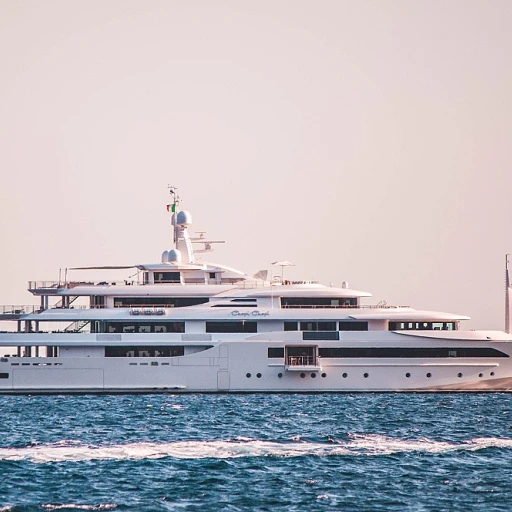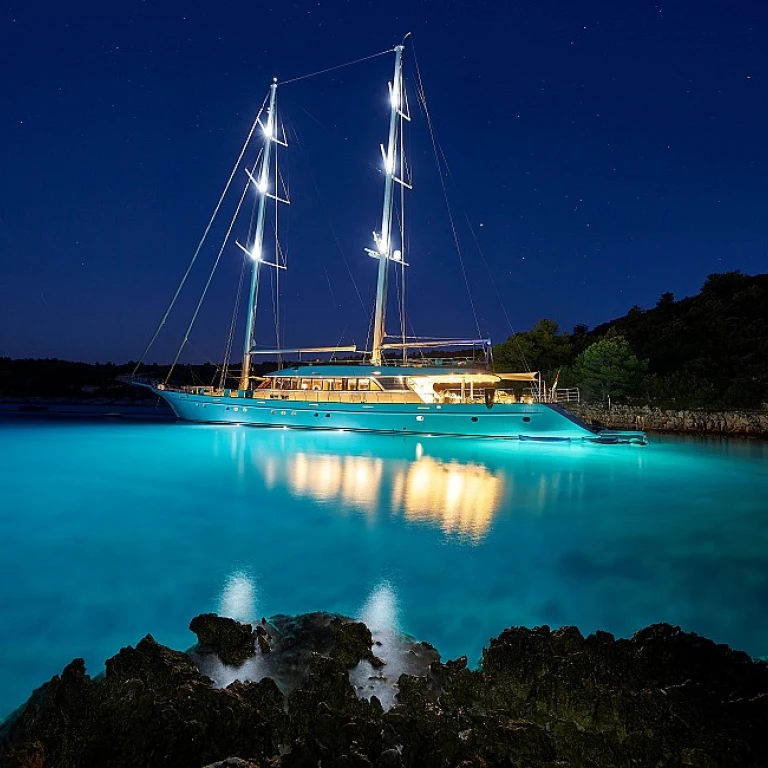Understanding the Beneteau 46 Toe Rail
The Role of Toe Rails in Yacht Design
In the world of yacht manufacturing, particularly when it comes to the esteemed Beneteau Oceanis line, the importance of certain elements can often be overlooked. Among these elements, the toe rail plays a pivotal role. As a Beneteau owner, understanding the nuances of your yacht’s features could enhance both safety and performance on the open seas.
The toe rail on the Beneteau 46 serves several purposes. It acts as a barrier to keep gear from sliding off the deck into the ocean and provides secure footing for navigating along the edges of the boat. With the challenges of oceanic conditions, having a sturdy toe rail is instrumental in ensuring safety.
The design of the toe rail for the Beneteau 46 is both functional and aesthetic. Crafted with precision, it often includes materials like teak and stainless steel, which not only add an elegant touch but also offer resilience against the rigors of saltwater environments. The choice of teak, in particular, is due to its natural oiliness, resistance to rot, and ability to withstand the weather. This makes teak toe rails a popular choice among yacht builders and owners alike.
However, the intricacies of the Beneteau 46 toe rail extend beyond just its material. Over the years, toe rails have evolved through innovative designs that not only enhance visual appeal but also contribute to the yacht's overall performance. For those looking to delve deeper into the lasting appeal and refurbishing of classic yacht elements, the
rehabilitation of a 1998 yacht offers interesting insights. It explores how classic designs have been revitalized to meet contemporary needs.
In this series, we’ll explore not only the materials and construction of the toe rail, but also delve into the challenges faced during installation, maintenance tips for longevity, and its impact on sailing performance.
The aim is to provide a comprehensive view of how this seemingly simple component plays an integral part in the overall functionality and aesthetic of a yacht, encouraging a newfound appreciation among yacht enthusiasts and Beneteau aficionados.
Materials and Construction
Quality and Crafting Excellence
The choice of materials and construction techniques in yacht manufacturing, especially for the Beneteau Oceanis range, showcases the commitment to quality that is highly revered in the industry. The use of durable materials for the toe rail, such as teak and stainless steel, not only enhances the yacht's aesthetic appeal but also contributes significantly to its functionality and longevity.
The Beneteau Oceanis 46, for instance, often features toe rails crafted from high-grade teak. This choice is due to teak's renowned resistance to harsh marine environments, where the salt-laden air and intense sun can cause severe damage over the years. Its natural oils and dense grain ensure the wood remains robust, even with prolonged exposure to unfavorable conditions. The distinctive orange tint of teak lends a striking look that is both classic and timeless, enhancing the overall view of the yacht.
In addition to teak, stainless steel is frequently used for elements like toe rails and handrails in the cockpit area. The corrosion resistance and strength of stainless steel make it a reliable choice for components that endure constant exposure to the elements. This commitment to high-quality materials is a message to Beneteau owners that their yachts are built to withstand the test of time and conditions.
For a closer look at how these materials contribute to the elegance and allure of yacht design, including aspects like the cockpit floor and seats,
explore the elegance of the Bella Vita yacht. This also ties into why these materials remain a popular choice for new yacht models in the United States and beyond.
Additionally, the construction techniques used in integrating these materials, such as precision in teak application and the securing of stainless steel components, play crucial roles in maintaining the integrity and aesthetic value of the yacht. Careful attention during the manufacturing process ensures each piece aligns perfectly with the yacht's hull and cockpit design, creating a seamless and professional finish that appeals to both new and seasoned yacht enthusiasts.
Installation Challenges
Installation Complexities and Considerations
To properly fit the toe rail on the Beneteau 46, precision and attentiveness are paramount. An understanding of the yacht’s original design specifications is essential for maintaining the intended structural integrity and aesthetic appeal. Installation challenges often arise due to the diverse materials, such as teak and stainless steel, employed in the construction.
One must consider the particularities of the Oceanis models, which can present unique difficulties during the toe rail installation. For instance, aligning the toe rail with the yacht’s hull and deck to achieve a seamless and secure fit requires meticulous measurement and skillful application.
Adequate preparation is necessary to combat common installation hurdles, such as the uneven surfaces of the teak toe rails. Careful sanding and leveling may be required to ensure a perfect fitting when the rail is installed onto the boat's structure.
The process may also involve collaboration with a team of professionals or likeminded Beneteau owners within groups, who can offer invaluable insights derived from years of experience. This communal knowledge exchange can streamline the installation process, honing in on challenges unique to the Beneteau Oceanis models.
In some cases, after successful installation, applying an appropriate coat to protect the teak toe rails from harsh marine environments will extend their longevity and maintain their appearance. This task underscores the importance of regular maintenance practices discussed more thoroughly in the following sections.
If you're interested in understanding how design influences installation, you can view insights into another perspective by exploring the allure of the King Baby yacht at
this detailed look at yacht design.
Maintenance Tips for Longevity
Ensuring the Longevity of Your Yacht's Toe Rail
Maintaining the Beneteau 46's toe rail is crucial for preserving its durability and overall appearance. The choice of materials, such as teak and stainless steel, not only enhances the aesthetic appeal but also plays a significant role in withstanding harsh marine environments. For Beneteau owners, particularly those of the Oceanis model, regular maintenance is necessary to ensure these materials perform optimally over the yacht's years.
To begin with, it's essential to keep the rails, including the bow thruster area and the cockpit floor, clean. Saltwater and dirt can build up over time, leading to potential degradation. A simple rinse with fresh water after each voyage is a practical step, but care should be taken to dry the surfaces properly to prevent watermarks and stains. Applying a coat of water-resistant sealant to the teak toe rail can help in maintaining its original orange tint, offering a vibrant view for years to come.
Regular inspections are also vital. This allows you to spot any signs of wear or damage early, particularly around the handrails in the cockpit and the office cell areas of the hull. Teak is susceptible to weathering and may require occasional light sanding and re-sealing to keep its rich hue. Stainless steel components, on the other hand, may benefit from stainless-specific polishes to maintain their luster and prevent rust.
For those with access to experts in the United States or part of a group of Beneteau enthusiasts, sharing insights via email or in-person can be invaluable. These messages and replies amongst members can offer practical advice and encourage proactive maintenance measures.
Finally, remember that effective maintenance is not just about preserving appearance but also about safeguarding the sailing performance of your yacht. Faulty toe rails can impact both safety and maneuverability, especially when sales are at stake or during a yacht's viewings. A well-maintained toe rail supports the overall function of the boat, contributing to a secure and enjoyable yachting experience.
Sailing Efficiency and Toe Rails
The design elements of the Beneteau 46, such as the toe rail, play a critical role in influencing the yacht's sailing performance. Unlike their aesthetic counterparts, the teak toe rails aren't simply there for visual appeal; they are a fundamental component in the management of deck drainage, which can directly affect sailing dynamics.
Proper water drainage ensures that the cockpit and hull maintain their intended balance and buoyancy, which is crucial when traversing challenging waters in your Beneteau Oceanis. Efficient water displacement along the toe rail pathways prevents added drag on the hull, a factor that can otherwise diminish sailing performance over time.
The thoughtfully constructed stainless steel and teak toe rails are designed to complement the sleek lines and forward motion of the Beneteau, allowing owners to experience both swift maneuverability and a smooth ride, whether you're entertaining guests on a calm summer day in the United States or navigating through a stunning coastal voyage.
Beneteau owners have noted that over the years, these specific toe rails tend to maintain their original condition with proper maintenance—further enhancing the vessel's reputation for longevity and durability. Regularly applying a coat of protective oil can help prevent the teak from developing an orange tint and preserve the material's integrity against harsh weather conditions.
In conclusion, the toe rail's contribution to the yacht's sailing performance is an integral part of what sets the Beneteau Oceanis apart from other models. By incorporating functional design with quality materials, the Oceanis line achieves a balance between visual allure and high-performance efficiency, ensuring each journey on the open sea is as enjoyable as it is efficient.
Comparative Analysis with Other Models
Toe Rails: A Comparative Glimpse
When examining the Beneteau Oceanis 46 toe rail in the context of other yacht models, several key differentiators come into play, specifically when considering materials, design, and practical applications. The use of teak in this model's construction, for instance, stands out for its traditional appeal and robustness, comparable to the likes of many premium yachts in the market. While the teak toe rail in the Oceanis serves both decorative and functional purposes, other models may opt for stainless steel or even synthetic options to offer variations in weight and maintenance requirements.
The message of quality permeates the design ethos of the Beneteau, as evidenced by its durable stainless steel element integrations. The decision matrix for Beneteau owners about toe rails often sways between aesthetic desires and functional necessities, where a choice between teak and stainless steel could also impact the yacht's maintenance regimen and the necessary application of protective coats.
In terms of installation challenges and performance, the Beneteau excels with a design that supports easy integration with the boat's original structure and assists in maintaining an orange tint-free finish, unlike some models which may exhibit such wear over years. This seamless blend integrates forward-thinking design with standard aesthetics common within the Beneteau yacht community.
Comparing sailing performance, the toe rail design aids the cockpit group by providing not just an enhanced view but also supporting the structural integrity essential in both leisure cruising and more robust oceanic challenges. Furthermore, minor design nuances such as the bow thruster placement and the teak cockpit floor's fluidity with handrails cockpit enhance its desirability over other models.
For Beneteau enthusiasts looking into yacht sales or upgrades, understanding these comparative nuances can be as vital as examining the seats teak or assessing the efficacy of the cockpit. The view must be both holistic and detailed, considering long-term sustainability, maintenance ease, and the rail's role in aesthetic and practical realms. Whether you are a new member exploring the thrilling world of yachts or a seasoned sailor discussing in an office cell, the conversation around these components will often boil down to sustainability against the enjoyable backdrop of yachting life in the United States and beyond.

